Not long ago, having a well-built website and a few SEO tactics was enough to stay competitive online. But that is no longer the world we live in. Search engines are not the only gateways anymore. People now find brands through voice search, AI recommendations, social platforms, mobile apps, and even map results.
If you want your brand to stand out, you need to think bigger—about every digital path where customers might find or interact with you.
The Nine O’s of Digital Visibility
Digital visibility sounds complex, but it becomes manageable when you look at it through nine key “O’s.” Each optimization strategy has a role to play in getting your brand seen, trusted, and chosen across every digital touchpoint.
- Search Engine Optimization (SEO)
This image was taken from Backlinko.
SEO remains the foundation of digital visibility. It determines whether your business appears when someone types a search on Google. In simple terms, SEO ensures that search engines can crawl, understand, and trust your website enough to rank it among the top results.
But effective SEO goes deeper than keywords. It rests on three primary pillars: technical health, high-quality content, and link building for better digital visibility.
To strengthen your SEO performance:
- Keep your website fast, mobile-friendly, and structurally sound.
- Build topic-focused content clusters that show depth and expertise, not just scattered keywords.
- Earn reputable backlinks through genuine outreach and PR, not shortcuts.
If SEO feels like it is too much to handle, you are not alone. It is not a one-time thing you tick off your list. Search engines keep changing their rules, so you have to keep up or get left behind. That is why most business owners leave SEO to experts.
An experienced SEO strategist looks at data, figures out what’s working and what’s missing, and fine-tunes your site’s technical parts, content, and links. Their job is to help your website rank better on search engine results pages (SERPs) and bring the right people to your business.
- Answer Engine Optimization (AEO)
Search is changing fast. People expect immediate, straight answers. They skip clicking links and head straight to voice assistants, AI searches, or Google’s instant answer boxes.
This “zero-click” trend means users often get their answers without ever reaching your site. AEO fixes this. It tailors your content to win the best spots: featured snippets, voice results, and rich snippets.
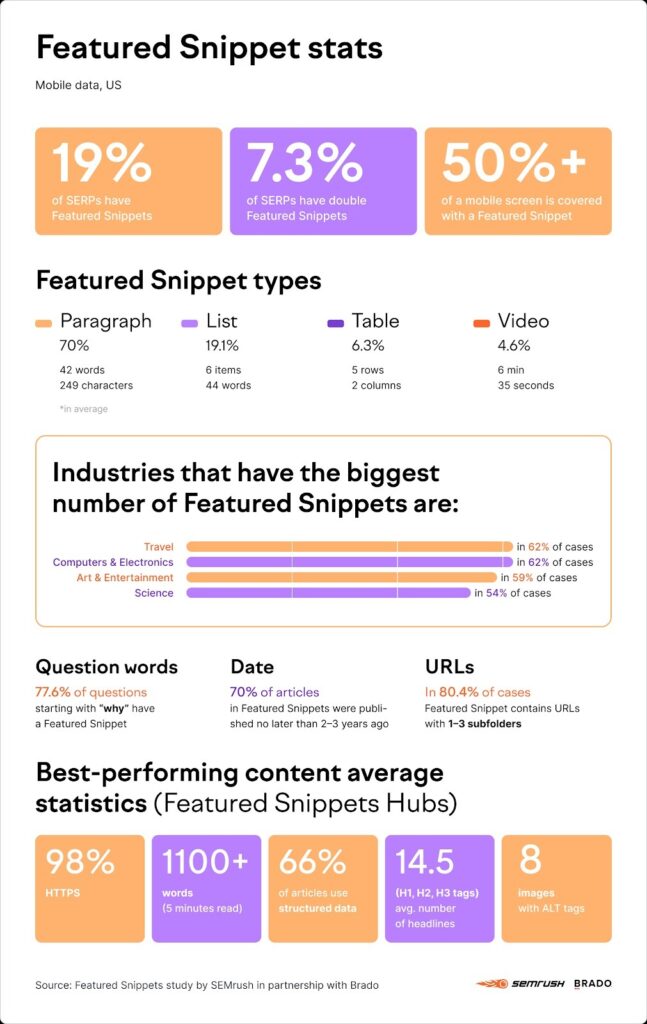
This image was taken from Semrush.
Here’s what to focus on to optimize content for answer engines:
- Use structured data so search engines understand what your content means, not just what it says.
- Format information with lists, summaries, and question-based sections.
- Build topical authority through Q&A-style content that fits how people ask questions out loud or in AI tools.
- App Store Optimization (ASO)
If your business has an app, its visibility in app stores matters as much as your website’s ranking on Google. App Store Optimization (ASO) makes your app easier to find in platforms like Apple’s App Store or Google Play Store, and more appealing to install.
This image was taken from Branch.
When people search for apps, they often choose the one with clearer benefits, better visuals, and stronger ratings. That’s ASO at work.
To boost your app’s visibility and downloads:
- Integrate relevant keywords naturally in your app title and description—no keyword stuffing.
- Engage with users by replying to reviews and maintaining your reputation.
- Use crisp icons, eye-catching screenshots, and short videos that highlight real use cases.
- Customize store listings for different regions to capture international users and improve conversion rates.
With billions of app users worldwide, ignoring ASO means missing out on a huge chunk of mobile visibility.
- Large Language Model Optimization (LLMO)
This one’s relatively new but is becoming necessary because the AI is the new front-end of the internet. Large language model optimization (LLMO) focuses on shaping your content so advanced generative AI tools like ChatGPT, Gemini, or Microsoft Copilot can easily understand, reference, and synthesize it.
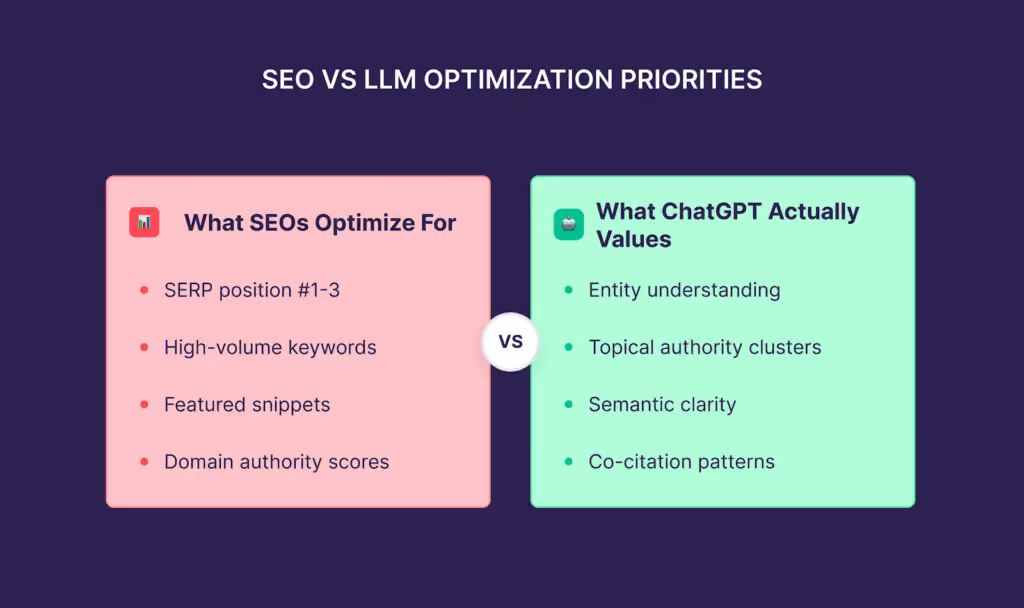
This image was taken from Backlinko.
As AI increasingly mediates how people find information and make decisions, optimizing for LLMs helps ensure your content stays relevant and is cited correctly. If the AI pulls information from you, you earn an invaluable AI citation.
To do this well, you need to treat your website like a reliable textbook—built for both humans and machines to learn from. Focus on:
- Writing clear, factual content with logical structure and proper citations.
- Defining your key topics and products consistently across your website.
- Keeping your brand information accurate across platforms to reinforce recognition.
- Anticipating how AI prompts might surface your content and format it accordingly.
- Generative Engine Optimization (GEO)
GEO goes one step further. While LLMO helps AI understand your content, generative engine optimization focuses on how AI tools present it in generated responses like summaries, chat answers, or AI-powered search results.
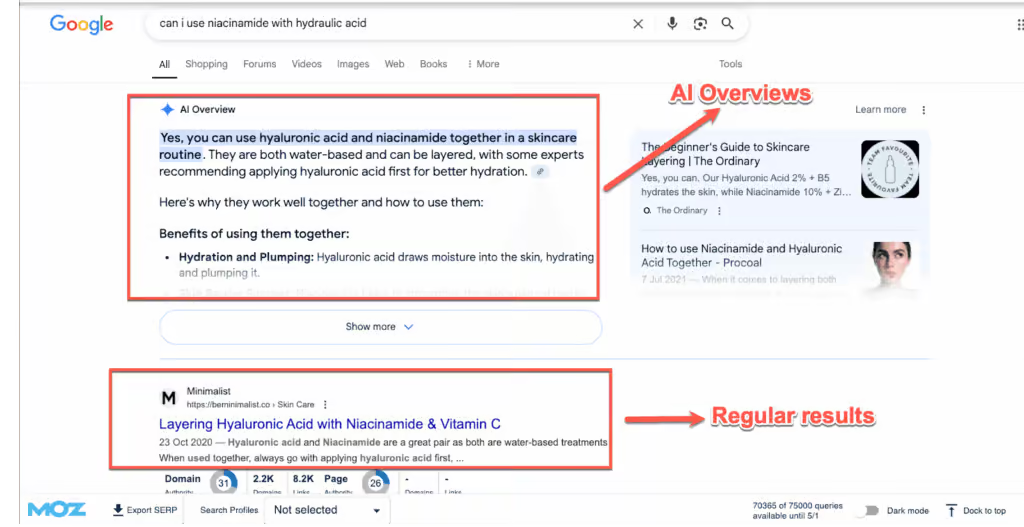
This image was taken from Moz.
It is no longer enough for AI to mention your brand; you want to control how it talks about you. Clear messaging, consistent tone, and accurate representation all start with how you write and structure your content today.
Here’s how to refine your GEO strategy:
- Be clear about who you are, what you do, and why it matters.
- Use simple formatting and consistent naming conventions to help AI systems interpret correctly.
- Reference credible sources and identify your authors or company clearly.
- Monitor how AI systems describe your brand and adjust your source material if something’s off.
- Build your tone and personality into your writing so even AI summaries sound like you.
- Conversion Rate Optimization (CRO)
Visibility alone does not guarantee business success. Imagine drawing a huge crowd to your store, but no one makes a purchase. That’s what visibility without conversion rate optimization (CRO) feels like.
CRO is about fine-tuning every step of your user journey to encourage meaningful action, such as purchasing, signing up, or requesting a quote. It transforms your traffic into real, measurable results. Small tweaks can make a big difference – changing a button’s color, simplifying a checkout form, or rewording a headline can double your conversions.
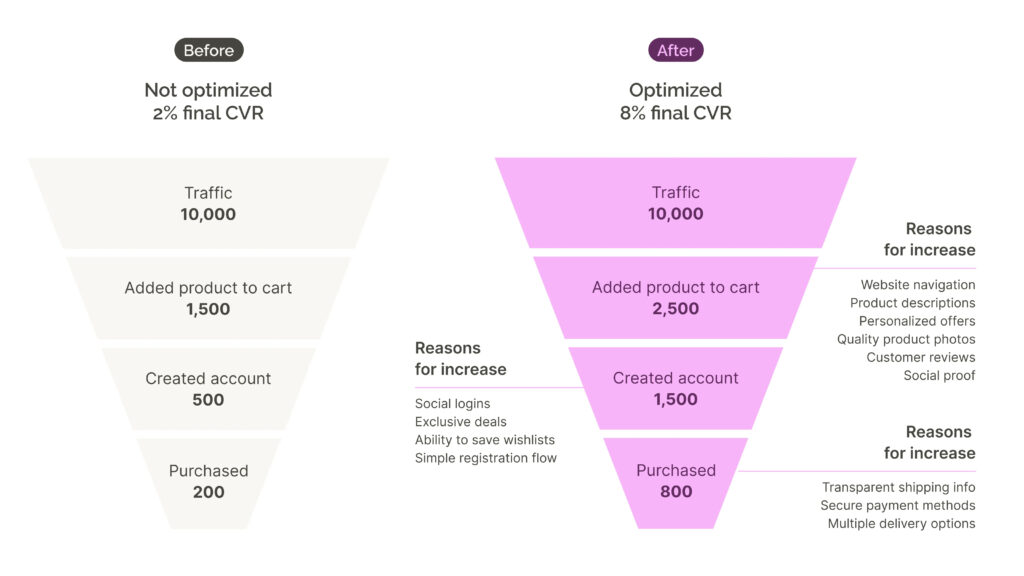
This image was taken from Wisepops.
To improve your CRO performance:
- Commit to rigorous A/B testing and multivariate testing of everything – from headline copy and button colors to full layout changes.
- Use heatmaps and analytics tools to see how users move through your site.
- Make forms shorter, reduce clicks, and remove friction wherever possible.
- Ensure your calls-to-action (CTAs) are clear, compelling, and placed perfectly within the customer journey mapping.
- Social Media Optimization (SMO)
Social media is not just for building brand awareness anymore. It is a powerful engine for driving visibility, sparking engagement, and even boosting SEO efforts.
Social Media Optimization (SMO) is about crafting platform-specific content that feels natural to each audience. It’s not about posting more often, but posting smarter. When done right, SMO builds trust, drives traffic, and strengthens your online reputation.
This image was taken from Digital Marketing Philippines.
Social proof – likes, comments, and shares – is today’s version of word-of-mouth. Those interactions send credibility signals to people and search engines that your business is relevant and deserving of attention.
Here’s how to make SMO work for you:
- Customize marketing content per platform—e.g., reels for Instagram, professional posts on LinkedIn, conversational tweets on X (Twitter).
- Use polls, questions, and user-generated content to start real conversations.
- Engaging actively by responding to comments and messages.
- Post when your audience is most active, not when it is convenient for you.
- Geographic Optimization (GEO-SEO)
When people search with a location in mind, they are often ready to act – whether that means visiting a store, booking a service, or making a local inquiry. That’s where geographic optimization (GEO-SEO) comes in.
GEO-SEO is about making your brand visible not just in one spot, but across multiple cities, states, or regions. It combines local SEO fundamentals with broader, region-specific strategies.
To do it right:
- Keep your Google Business Profile (GBP) updated – hours, services, images, and reviews. Respond to every review, good or bad.
- Ensure your business name, address, and phone number are consistent across all listings.
- Create dedicated landing pages for every location with unique, region-specific content—not duplicates.
- If your business serves multiple regions or languages, configure your site so visitors see content tailored to their area.
- Use geo-targeted keywords naturally and pay attention to what local competitors are doing online.
- Add local context. Mention community events, local laws, or area-specific tips to show you understand the region.
- AI Optimization (AIO)
AI optimization (AIO) is not about ranking higher in AI tools. It is about leveraging artificial intelligence, machine learning, and predictive analytics to make your marketing smarter, faster, and more efficient.
AI is now integrated into nearly every area of digital marketing. From predictive analytics to automated personalization, AIO helps your team focus on strategy while the technology handles the heavy lifting.
When done right, AIO turns data into decisions and insights into action. Here’s how:
- Use AI for anomaly detection in your traffic or conversion data, catching and addressing issues before they become major problems.
- Leverage predictive analytics to forecast which audience segments are high-value and find the ideal time to post on social media.
- Utilize AI for automated content refinement, like optimizing hundreds of title tags or meta descriptions for better click-through rates.
- Integrate AI for personalized email sequences and ad delivery, moving past simple segmentation to real one-to-one connections.
Conclusion
There is no single “magic formula” for online visibility anymore. SEO might be your foundation, but it is only one piece of a larger picture. When you bring the other ‘O’s into play – AEO, ASO, LLMO, GEO, CRO, SMO, GEO-SEO, and AIO – you build more than visibility. You build authority and trust that fuels growth.
The digital world moves too fast for you to “set it and forget it.”
What should you do next?
- Audit: Reflect on which “O” is already working for you—and which needs the most attention.
- Strategize: Prioritize strategy based on your customer journey, not just what is trendy.
- Experiment: Test, measure, and refine your visibility strategy to optimize its effectiveness.
Digital visibility is not a one-time project. It is an ongoing process of learning, adjusting, and staying ahead. The sooner you start mastering the O’s, the stronger and more resilient your online presence will be in an ever-changing online world.
If you are ready to learn how to choose the right ‘O’s for your digital presence, I’m here to help. As a digital marketing consultant, I will work with you to pick the right strategies that match your goals and actually help your business grow.
Contact me today to get started.
References
https://ahrefs.com/blog/geo-is-just-seo/
https://blog.hubspot.com/marketing/seo-strategy
https://www.llmometrics.com/blog/answer-engine-optimization-how-to-rank-in-the-age-of-ai-responses
https://writesonic.com/blog/what-is-geo-aeo-llmo
https://www.apptweak.com/en/aso-blog/what-is-app-store-optimization-and-why-is-aso-important
https://www.blog.udonis.co/mobile-marketing/mobile-apps/complete-guide-to-app-store-optimization
https://backlinko.com/seo-vs-geo
https://www.semrush.com/blog/geo-targeting-seo
https://www.shopify.com/ph/blog/social-media-optimization
https://digitalmarketinginstitute.com/blog/a-best-practice-guide-to-social-media-marketing
https://businessinnovatorsmagazine.com/seo-vs-aio-navigating-the-future-of-digital-visibility/
